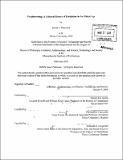| dc.contributor.advisor | Merritt Roe Smith. | en_US |
| dc.contributor.author | Pietruska, Jamie L | en_US |
| dc.contributor.other | Massachusetts Institute of Technology. Program in Science, Technology and Society. | en_US |
| dc.date.accessioned | 2009-10-01T15:48:04Z | |
| dc.date.available | 2009-10-01T15:48:04Z | |
| dc.date.copyright | 2009 | en_US |
| dc.date.issued | 2009 | en_US |
| dc.identifier.uri | http://hdl.handle.net/1721.1/47827 | |
| dc.description | Thesis (Ph. D. in History, Anthropology, and Science, Technology and Society (HASTS))--Massachusetts Institute of Technology, Program in Science, Technology and Society, 2009. | en_US |
| dc.description | Includes bibliographical references (v. 2, leaves 316-340). | en_US |
| dc.description.abstract | This study of the changing practices and perceptions of prediction in the late nineteenth century reveals the process by which Americans came to rationalize economic and cultural uncertainty into modern life. Forecasts of all kinds were ubiquitous in the late nineteenth century; as the United States fashioned itself into an urban-industrial power with a national economy and an increasingly corporate and bureaucratic society, prediction became an increasingly significant scientific, economic, and cultural practice. As a postbellum crisis of certainty destabilized ways of thinking about the future-in science, social science, and religion-predictions, whether accurate or not, offered illusions of control over one's future to citizens of a rapidly modernizing America. I argue that the late-century search for predictability found as much uncertainty as it did certainty, that consumers of predictions were at once desirous and dismissive of forecasts that often took on greater cultural than economic value, and that producers and consumers of prediction together rationalized uncertainty and shaped a new cultural acceptance of the predictable unpredictability of modern life. In the first half of the dissertation I analyze the work of U.S. Department of Agriculture statisticians, private cotton estimators, Weather Bureau forecasters, and local "weather prophets," all of whom sought to systematically convert their observations into economically valuable predictions. In the second half of the dissertation I focus on the work of utopian novelist Edward Bellamy, fortune-tellers, and spirit mediums, whose prophecies circulated by the thousands through rural and urban America. | en_US |
| dc.description.abstract | (cont.) "Propheteering" offers a new narrative of modernization by examining the tools and cultural practices used by both institutions and individuals to make sense of the late-century scientific and social reimagination of the future, however uncertain and fragmentary that future promised to be. | en_US |
| dc.description.statementofresponsibility | by Jamie L. Pietruska. | en_US |
| dc.format.extent | 2 v. (340 leaves) | en_US |
| dc.language.iso | eng | en_US |
| dc.publisher | Massachusetts Institute of Technology | en_US |
| dc.rights | M.I.T. theses are protected by
copyright. They may be viewed from this source for any purpose, but
reproduction or distribution in any format is prohibited without written
permission. See provided URL for inquiries about permission. | en_US |
| dc.rights.uri | http://dspace.mit.edu/handle/1721.1/7582 | en_US |
| dc.subject | Program in Science, Technology and Society. | en_US |
| dc.title | Propheteering : a cultural history of prediction in the Gilded Age | en_US |
| dc.title.alternative | Cultural history of prediction in the Gilded Age | en_US |
| dc.type | Thesis | en_US |
| dc.description.degree | Ph.D.in History, Anthropology, and Science, Technology and Society (HASTS | en_US |
| dc.contributor.department | Massachusetts Institute of Technology. Program in Science, Technology and Society | |
| dc.identifier.oclc | 429488506 | en_US |
